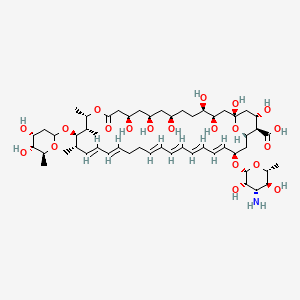Nystatin A3
Nystatin A3 is a lipid of Polyketides (PK) class. Nystatin a3 is associated with abnormalities such as Mycoses, Candidiasis of the genitals and Gigantism. The involved functions are known as Drug Interactions, Process, Synthesis, Fermentation and Anabolism. Nystatin a3 often locates in Cell membrane, Membrane, Protoplasm, Entire oral cavity and integral to membrane. The associated genes with Nystatin A3 are Gene Clusters. The related lipids are Sterols, 1,2-oleoylphosphatidylcholine, Membrane Lipids, DOPE and N-caproylsphingosine.
Cross Reference
Introduction
To understand associated biological information of Nystatin A3, we collected biological information of abnormalities, associated pathways, cellular/molecular locations, biological functions, related genes/proteins, lipids and common seen animal/experimental models with organized paragraphs from literatures.
What diseases are associated with Nystatin A3?
Nystatin A3 is suspected in Mycoses, Candidiasis of the genitals, Gigantism and other diseases in descending order of the highest number of associated sentences.
Related references are mostly published in these journals:
| Disease | Cross reference | Weighted score | Related literature |
|---|
Possible diseases from mapped MeSH terms on references
We collected disease MeSH terms mapped to the references associated with Nystatin A3
PubChem Associated disorders and diseases
What pathways are associated with Nystatin A3
There are no associated biomedical information in the current reference collection.
PubChem Biomolecular Interactions and Pathways
Link to PubChem Biomolecular Interactions and PathwaysWhat cellular locations are associated with Nystatin A3?
Visualization in cellular structure
Associated locations are in red color. Not associated locations are in black.
Related references are published most in these journals:
| Location | Cross reference | Weighted score | Related literatures |
|---|
What functions are associated with Nystatin A3?
Related references are published most in these journals:
| Function | Cross reference | Weighted score | Related literatures |
|---|
What lipids are associated with Nystatin A3?
Related references are published most in these journals:
| Lipid concept | Cross reference | Weighted score | Related literatures |
|---|
What genes are associated with Nystatin A3?
Related references are published most in these journals:
| Gene | Cross reference | Weighted score | Related literatures |
|---|
What common seen animal models are associated with Nystatin A3?
There are no associated biomedical information in the current reference collection.
NCBI Entrez Crosslinks
All references with Nystatin A3
Download all related citations| Authors | Title | Published | Journal | PubMed Link |
|---|---|---|---|---|
| Honsho M et al. | Plasmalogen biosynthesis is spatiotemporally regulated by sensing plasmalogens in the inner leaflet of plasma membranes. | 2017 | Sci Rep | pmid:28272479 |
| Gadd GM | New horizons in geomycology. | 2017 | Environ Microbiol Rep | pmid:27701824 |
| Walmsley S et al. | Engineered biosynthesis and characterisation of disaccharide-modified 8-deoxyamphoteronolides. | 2017 | Appl. Microbiol. Biotechnol. | pmid:27858138 |
| Kinoshita H et al. | Anti-Rhodotorula activity of mycophenolic acid enhanced in the presence of polyene antibiotic nystatin. | 2017 | Lett. Appl. Microbiol. | pmid:27801509 |
| Lee JH et al. | Lineage-Specific Differentiation Is Influenced by State of Human Pluripotency. | 2017 | Cell Rep | pmid:28380358 |
| Sardi JC et al. | Unexplored endemic fruit species from Brazil: Antibiofilm properties, insights into mode of action, and systemic toxicity of four Eugenia spp. | 2017 | Microb. Pathog. | pmid:28259673 |
| Girotra P et al. | Identification of multi-targeted anti-migraine potential of nystatin and development of its brain targeted chitosan nanoformulation. | 2017 | Int. J. Biol. Macromol. | pmid:28041915 |
| Mohammadi G et al. | Preparation, Physicochemical Characterization and Anti-fungal Evaluation of Nystatin-Loaded PLGA-Glucosamine Nanoparticles. | 2017 | Pharm. Res. | pmid:27928646 |
| Hellfritzsch M et al. | Topical Antimycotics for Oral Candidiasis in Warfarin Users. | 2017 | Basic Clin. Pharmacol. Toxicol. | pmid:27901310 |
| Peixoto LR et al. | Antifungal activity, mode of action and anti-biofilm effects of Laurus nobilis Linnaeus essential oil against Candida spp. | 2017 | Arch. Oral Biol. | pmid:27771586 |
